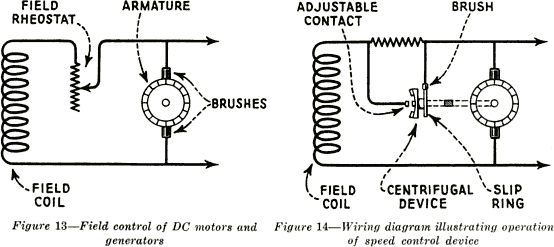Figures 11 and 12, show a loop rotating in a magnetic field. In practice a large number of loops
are used and they are mounted on an iron core. This iron core reduces the length of the magnetic field
in air, and therefore makes it easier to create a strong magnetic field. The space between the, rotating
iron core carrying the rotating windings and the poles is, called the air gap. This air gap varies with the design and
size of the motors. For small machines it is sometimes only a few thousands of an inch, while for large
generators the air gap may be several inches wide. The rotating part of motors and generators is
called the "rotor." In all DC machines and in some AC machines, it is often called the "armature" of
the motor or generator. Strictly speaking, the armature is that part of the machine wherein the
magnetic field rotates with respect to the windings.
24. Voltage Control of Generators.- As stated earlier in this chapter, the voltage generated in a
conductor which is moved through a magnetic field depends upon the number of lines of force cut by
the conductor in a second of time. Therefore if the speed with which the conductor cuts the lines of force is increased, the voltage generated
will be increased. There are two ways of increasing the number of lines of force cut per second by a
conductor; one is to speed up the movement of the conductor, and the other is to increase the
number of lines of force.

The speed of generators is usually constant, and the voltage is regulated by changing the field
strength (increasing or decreasing the number of lines of force in the field). The field strength is
controlled by the current in the field winding, and this current is controlled by putting resistance in
series with the field winding. See Figure 13. This resistance is made variable, and the device for
changing the resistance is called a "rheostat." When resistance is "cut out" of the field circuit, the
current increases so that that number of lines of force are increased, and the generated voltage
increases in proportion to the increase of the magnetic lines of force of the field. The voltage of a
generator is decreased by increasing the resistance in the field circuit, and thereby decreasing the
field current.
5
